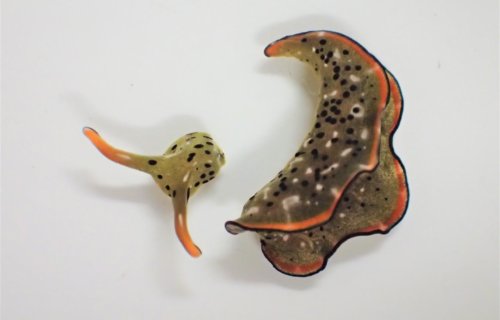NARA, Japan — Scientists have discovered a type of sea slug that’s capable of regenerating its entire body, including all internal organs. Researchers say the sacoglossan slugs feast on photosynthetic algae, which may aid in their survival during this fascinating shedding-regeneration process.
Sayaka Mitoh, a researcher and Ph.D. candidate with the Yoichi Yusa lab at Nara Women’s University in Japan, stumbled upon the phenomenon while studying specific traits of sea slugs they had raised from eggs. Mitoh witnessed a sacoglossan slug moving about after shedding most of its body.
According to Mitoh, this occurred twice for one slug after losing most of its body in the process known as autotomy.
“We were surprised to see the head moving just after autotomy,” Mitoh explains in a media release. “We thought that it would die soon without a heart and other important organs, but we were surprised again to find that it regenerated the whole body.”
The head, which had been removed from the body, moved by itself as soon as the separation occurred. A few hours after separation, the younger slugs began feeding on algae even though they did not have bodies. The incision near the back of the skull healed in a matter of days. Within a week, the heart started to regenerate. The entire regeneration process took around three weeks.
The older slugs died within 10 days because they did not continue to eat. Although the bodies that lacked heads did not recreate new ones, they did respond to stimuli for many days after the separation.
Researchers at the Yusa lab believe the ability comes from cells near the neck that have the capability to reproduce the rest of the body. The reason behind the separation is still unknown, however, researchers suspect the slugs undergo this process to rid their bodies of parasites that may prevent them from reproducing.
The researchers at Yusa’s lab plan to continue this research to determine what initiates and executes the process.
These species of slugs are already distinctive for their utilization of algae chloroplasts which allow them to carry out photosynthesis. This process referred to as kleptoplasty may also be what keeps them alive for full regeneration to occur. Although some other organisms are capable of regeneration, these sea slugs demonstrate a unique kind of autotomy-regeneration process that no other organism has ever shown.
“As the shed body is often active for months, we may be able to study the mechanism and functions of kleptoplasty using living organs, tissues, or even cells,” Mitoh said. “Such studies are almost completely lacking, as most studies on kleptoplasty in sacoglossans are done either at the genetic or individual levels.”
This study is published in Current Biology.
